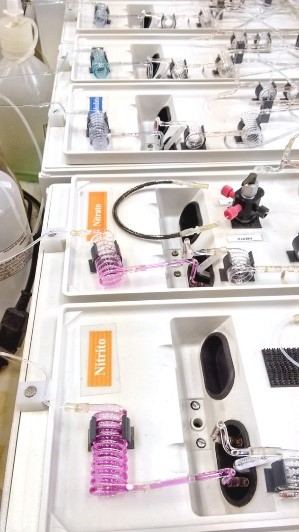Advanced Rio lab warns of Olympic water quality danger
A lack in progress over 20 years
Scientists at the Federal University of Rio de Janeiro, who have been testing the waters around Rio for the last 20 years, have expressed disappointment with the lack of progress being made in preparation for the 2016 Olympics. Employing advanced technology from SEAL Analytical, the university’s marine biology laboratory has revealed worrying trends for parameters such as ammonia, nitrates and phosphates.
Floating Debris - Navigation Hazard
Guanabara Bay sits beneath the iconic Sugar Loaf Mountain, and is set to be the location for the sailing events of the 2016 Olympics. However, practicing international contestants have complained of debris in the water presenting a hazard and there is concern that the event may have to be moved further out to sea. “Sailors have reported floating TV sets, sofas and dead animals,” says the University’s Professor Rodolfo Paranhos. “These items present a physical hazard that can damage a yacht or get caught up in the rudder, causing it to lose its place in a race. However, chemical and biological pollution represents a potentially more serious threat, because of the diseases that can arise from sewage pollution.”
Rivers are Anoxic - Millions of liters of untreated sewage daily
Greater Rio has a population of over 10 million people and millions of litres of untreated sewage are discharged into Guanabara Bay and into the rivers that feed it, every day. As a result, these rivers are largely anoxic – incapable of supporting normal aquatic life. The Brazilian government has taken some initiatives to address the pollution, with nets preventing debris from entering the bay and so-called ‘Eco-Boats’ scooping up floating and slightly submerged debris. There has also been some effort to reduce the amount of untreated sewage reaching the bay, but Professor Paranhos says: “It is probably now too late to solve the problem, because of the infrastructure that would be required to provide effective sewage treatment. However, importantly, this would be an indication that the promised environmental legacy of Rio 2016 has failed.”
Advanced Rio lab warns of Olympic water quality danger
The analysis of water samples from Guanabara Bay has revealed worrying trends in water pollution. High levels of ammonia and total nitrogen have been caused by population growth without concurrent growth of sanitary infrastructure. As a result, the area’s rivers are largely dead, biodiversity is damaged, and some of Rio’s beaches are unsafe for swimming or other water based activities.
A large number of samples must be analyzed
With the benefit of 20 years’ of data, the University’s laboratory is able to identify both pollution incidents and long-term trends. “This necessitates the analysis of large numbers of samples, with a major focus on accuracy and reliability,” says Rodolfo. “So, we participate in an international calibration exercise to ensure that our results are highly accurate, and the installation in 2012 of a five channel SEAL AA3 automated continuous segmented flow analyzer, has provided a tremendous increase in sample throughput capacity.
Test many more samples - Same level of funding
Prior to the arrival of the AA3, all of our samples were individually tested manually with a spectrophotometer, but we are now able to analyse multiple samples simultaneously for parameters such as ammonia, nitrate, nitrite, orthophosphate, silicates, total nitrogen and total phosphorus. Typically, we test 40 to 50 samples per day, but with the AA3 we can easily increase this to 100 when necessary. This means that we are now able to test many more samples with the same level of funding so I am naturally extremely happy with the SEAL analyzer.

Other Rio 2016 events dependent on water quality
Other Rio 2016 events will also be dependent on water quality. For example, the triathlon swimming will take place at the Copacabana and the rowing events will take place on the Rodrigo de Freitas lake, which recently suffered a major fish kill. “This may not be due to pollution,” Rodolfo comments. “The lake contains a high level of sediment which is disturbed during high winds and this could cause a sudden drop in dissolved oxygen, which would cause fish to die. Unfortunately, we do not have funding to test the lake so, at this stage, we cannot be certain.”
Increased workflow - High levels of accuracy
In summary, the automated segmented flow analyzer, SEAL AA3, enable laboratories to dramatically increase work flow, whilst maintaining high levels of accuracy and reliability without incurring high operational costs. These benefits are exemplified by the marine biology laboratory at the Federal University of Rio de Janeiro, which has demonstrated the advantages of long-term monitoring programs in the identification of water quality trends. The knowledge that this data provides can then inform science-based political decisions, and one can only hope that urgent action will be taken to ensure a safe Olympics with a legacy that benefits the Rio de Janeiro environment.
Precise and Reliable Seawater Analyses
SEAL Analytical are world-wide leaders in the supply of segmented flow and discrete analyzers for Seawater and environmental analysis. The high precision and reproducibility, robust design and low detection limit of SEAL analyzers make them the first choice for seawater analysis. Leading seawater laboratory and research institutes use the SEAL AutoAnalyzer and QuAAtro. As well as being reliable laboratory instruments, these analyzers are designed to stand up to tough conditions on board an oceangoing research vessel, and are in routine ship-board use from the Arctic Ocean to the Weddel Sea. The latest instruments use LED light sources which have long life and are unaffected by vibration and are extremely stable. They were developed specifically for trace-level on-board seawater analysis.